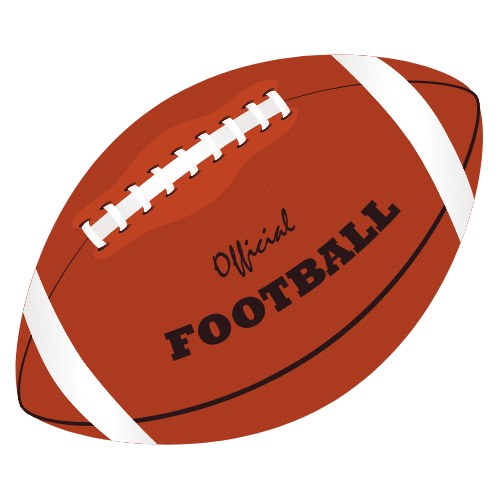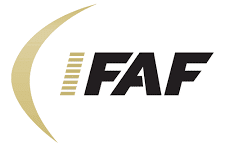Rule 2 - Definitions
SECTION 21. Scrimmage
Article 1 - Scrimmage Down
A scrimmage down is the action between the two teams during a down that begins with a legal snap.
NOTE: A try down is a scrimmage down that begins when the referee declares the ball ready for play (Rule 8-3-2-b).
Article 2 - Scrimmage Line
SECTION 22. Shift
Article 1 - Shift
a. A shift is a simultaneous change of position or stance by two or more offensive players after the ball is ready for play before the snap for a scrimmage down. (A.R. 7-1-3:I-II) (A.R. 7-1-2:I-IV)
b. The shift ends when all players have been motionless for one full second.
c. The shift continues if one or more players are in motion before the end of the one second interval.
SECTION 23. Snapping the Ball
Article 1 - Snapping the Ball
a. Legally snapping the ball (a snap) is handing or passing it backward from its position on the ground with a quick and continuous motion of the hand or hands, the ball actually leaving the hand or hands in this motion (Rule 4-1-4).
b. The snap starts when the ball is moved legally and ends when the ball leaves the snapper’s hands; the ball then becomes alive (Rule 4-1-1) (A.R. 7-1-5:I-II).
c. If, during any backward motion of a legal snap, the ball slips from the snapper’s hand, it becomes a backward pass and is in play (Rule 4-1-1)
d. While resting on the ground and before the snap, the long axis of the ball must be at right angles to the scrimmage line (Rule 7-1-3).
e. Unless moved in a backward direction, the movement of the ball does not start a legal snap. It is not a legal snap if the ball is first moved forward or lifted.
f. If the ball is touched by Team B during a legal snap, the ball remains dead and Team B is penalised. If the ball is touched by Team B during an illegal snap, the ball remains dead and Team A is penalised. (A.R. 7-1-5:I-II).
g. The snap need not be between the snapper’s legs; but to be legal, it must be a quick and continuous backward motion.
h. The ball must be snapped on or between the hash marks.
SECTION 24. Series and Possession Series
Article 1 - Series
Article 2 - Possession Series
SECTION 25. Spots
Article 1 - Enforcement Spot
An enforcement spot is the point at which the penalty for a foul or the result of a violation is enforced.
Article 2 - Previous Spot
The previous spot is the point at which the ball was last put in play.
Article 3 - Succeeding Spot
The succeeding spot is the point at which the ball is next to be put in play.
Article 4 - Dead-Ball Spot
The dead-ball spot is the point at which the ball became dead.
Article 5 - Spot of the Foul
The spot of the foul is the point at which that foul occurs. If out of bounds between the goal lines, it shall be the intersection of the nearer hash mark and the yard line extended through the spot of the foul. If out of bounds between the goal line and the end line or behind the end line, the foul is in the end zone.
Article 6 - Out-of-Bounds Spot
The out-of-bounds spot is the point at which the ball becomes dead by rule because of going or being declared out of bounds.
Article 7 - Inbounds Spot
The inbounds spot is the intersection of the nearer hash mark line and the yard line passing through either the dead-ball spot or the spot where a penalty leaves the ball in a side zone.
Article 8 - Spot Where Run Ends
The spot where the run ends is the point:
a. Where the ball is declared dead in player possession.
b. Where player possession is lost on a fumble.
c. Where handing of the ball occurs.
d. Where an illegal forward pass is thrown.
e. Where a backward pass is thrown.
f. Where an illegal scrimmage kick is made beyond the line of scrimmage.
g. Where a return kick occurs.
h. Where player possession is gained under provisions of the "momentum rule" (Rule 8-5-1-a Exceptions).
Article 9 - Spot Where Kick Ends
A scrimmage kick that crosses the neutral zone ends at the spot where it is caught or recovered or where the ball is declared dead by rule (Rule 2-16-1-c). (Exception: If inadvertent whistle provisions apply, the end of a kick is where the ball next touches a player, official, the ground or crosses a boundary line after the whistle has blown.).
Article 10 - Basic Spot
The basic spot is a benchmark for locating the enforcement spot for penalties governed by the Three-and-One Principle (Rule 2-33). Basic spots for the various categories of plays are given in Rule 10-2-2-d.
Article 11 - Postscrimmage Kick Spot
The postscrimmage kick spot serves as the basic spot when postscrimmage kick enforcement applies (Rule 10-2-3).
a. When the kick ends in the field of play, other than in the special cases given below, the postscrimmage kick spot is the spot where the kick ends.
b. When the kick ends in Team B’s end zone, the postscrimmage kick spot is Team B’s 20-yard line.
Special cases:
1. On an unsuccessful field goal attempt, if the ball is untouched by Team B after crossing the neutral zone and is declared dead beyond the neutral zone, the postscrimmage kick spot is:
(a) The previous spot, if the previous spot is on or outside Team B’s 20-yard line; (A.R. 10-2-3:V)
(b) Team B’s 20-yard line, if the previous spot is between Team B’s 20-yard line and its goal line.
2. When Rule 6-3-11 is in effect, the postscrimmage kick spot is Team B’s 20-yard line.
3. When Rule 6-5-1-b is in effect, the postscrimmage kick spot is the spot where the receiver first touched the kick.
SECTION 26. Tackling
Tackling is grasping or encircling an opponent with a hand(s) or arm(s).
SECTION 27. Team and Player Designations
Article 1 - Teams A and B
Article 2 - Offensive and Defensive Teams
Article 3 - Kicker and Holder
a. The kicker is any player who punts, drop kicks or place kicks according to rule. He remains the kicker until he has had a reasonable time to regain his balance.
b. A holder is a player who controls the ball on the ground or on a kicking tee. During a scrimmage-kick play, he remains the holder until no player is in position to make the kick or, if the ball is kicked, until the kicker has had a reasonable time to regain his balance.
Article 4 - Lineman and Back
a. Lineman.
1. A lineman is any Team A player legally on his scrimmage line (Rule 2-21-2).
2. A Team A player is legally on the scrimmage line when facing their opponent’s goal line with the line of his shoulders approximately parallel thereto and either (a) he is the snapper (Rule 2-27-8) or (b) his head breaks the plane of the line drawn through the waistline of the snapper.
b. Interior lineman. An interior lineman is a lineman who is not on the end of his scrimmage line.
c. Restricted lineman. A restricted lineman is any interior lineman, or any lineman wearing a number 50-79, whose hand(s) are below the knees.
d. Back.
1. A back is any Team A player who is not a lineman and whose head or shoulder does not break the plane of the line drawn through the waistline of the nearest Team A lineman.
2. A back is also the player in position to receive a hand-to-hand snap.
3. A lineman becomes a back before the snap when he moves to a position as a back and stops.
Article 5 - Forward Passer
The forward passer is the player who throws a forward pass. That player is a forward passer from the time the ball is released until the pass is complete, incomplete or intercepted, or until he moves to participate in the play.
Article 6 - Player
a. A player is any one of the participants in the game who is not a substitute or a replaced player and is subject to the rules when inbounds or out of bounds.
b. An airborne player is a player not in contact with the ground because he/she has has leapt, jumped, dived, launched, or beenc ontacted by an opponent or teammate, etc. in other than normal running action.
c. A departing player is a player leaving the field, having been replaced by a substitute.
d. A teammate is a player of the same team
Article 7 - Runner and Ball Carrier
a. The runner is a player in possession of a live ball or simulating possession of a live ball.
b. A ball carrier is a runner in possession of a live ball.
Article 8 - Snapper
The snapper is the player who snaps the ball. That player is established as the snapper when he takes a position behind the ball and touches or simulates (hand(s) at or below his knees) touching the ball (Rule 7-1-3).
Article 9 - Substitute
a. A legal substitute is a replacement for a player or a player vacancy during the interval between downs.
b. A legal incoming substitute becomes a player when he enters the field of play or end zones and communicates with a teammate or an official, enters the huddle, is positioned in an offensive or defensive formation, or participates in a play.
Article 10 - Replaced Player
Article 11 - Player Vacancy
Article 12 - Disqualified Player
a. A disqualified player is one who is declared ineligible for further participation in the game.
b. A disqualified player or coach must leave the playing enclosure under the escort of team personnel before the next play after his disqualification. He must remain out of view of the field of play under team supervision for the duration of the game.
Article 13 - Squad Member
Article 14 - Defenseless player
A defenseless player is one who because of his physical position and focus of concentration is especially vulnerable to injury. When in question, a player is defenseless.
Examples of defenseless players include but are not limited to:
a. A player in the act of or just after throwing a pass.
b. A receiver attempting to catch a forward pass or in position to receive a backward pass, or one who has completed a catch and has not had time to protect himself or has not clearly become a ball carrier.
c. A kicker in the act of or just after kicking a ball, or during the kick or the return.
d. A kick returner attempting to catch or recover a kick, or one who has completed a catch or recovery and has not had time to protect himself or has not clearly become a ball carrier.
e. A player on the ground.
f. A player obviously out of the play.
g. A player who receives a blind-side block.
h. A ball carrier already in the grasp of an opponent and whose forward progress has been stopped.
i. A quarterback any time after a change of possession.
j. A ball carrier who has obviously given himself up and is sliding feet-first.
Article 15 - Player Out of Bounds and In Bounds
a. Out of Bounds
1. A player is out of bounds when any part of his body touches anything other than another player or a game official on or outside a boundary line.
2. An out-of-bounds player who becomes airborne remains out of bounds until he touches the ground in bounds without simultaneously being out of bounds.
b. In Bounds
1. An inbounds player is a player who is not out of bounds.
2. An inbounds player who becomes airborne remains in bounds until he is out of bounds.
Article 16 - Definition of coach
a. A coach is a person subject to the rules who, while in the team area, coaching box, press box (or another authorised place within the playing enclosure), observes the game and/or gives instructions to players and substitutes.
b. A player/coach is regarded as being a coach when in the team area or coaching box and as a player or substitute otherwise.
c. Each team shall designate a coach as its head coach, and identify him on the roster form and to the referee. A head coach disqualified from the game may designate a new head coach (Rule 9-2-6-d).
SECTION 28. Tripping
Tripping is intentionally using the lower leg or foot to obstruct an opponent below the knees (Rule 9-1-2-c).
SECTION 29. Timing Devices
Article 1 - Game Clock
The game clock is any device under the direction of the appropriate official used to time the duration of the game.
Article 2 - Play Clock
a. Each stadium should have a visual play clock at each end of the playing enclosure. The play clock (if provided) must be capable of counting down from both 40 seconds and 25 seconds. It should automatically default to 40 seconds and start immediately upon being reset by the play-clock operator when any official signals that the ball is dead after a play.
b. Otherwise, the play clock is any device under the direction of the appropriate official used to time the 40/25 seconds between end of the previous play or the ready for play signal and the ball being put in play.
SECTION 30. Play Classification
Article 1 - Forward Pass Play
A legal forward pass play is the interval between the snap and when a legal forward pass is complete, incomplete or intercepted.
Article 2 - Free Kick Play
A free kick play is the action during the interval from the time the ball is legally kicked until it comes into player possession or is declared dead by rule.
Article 3 - Scrimmage Kick Play
A scrimmage kick play is the action during the interval between the snap and when a scrimmage kick comes into player possession or the ball is declared dead by rule.
Article 4 - Running Play and Run
a. A running play is any live-ball action other than that during a free kick play, a scrimmage kick play, or a legal forward pass play.
b. A run is that segment of a running play during which a ball carrier has possession.
c. If a ball carrier loses possession by a fumble, backward pass, or illegal forward pass, the spot where the run ends (Rule 2-25-8) is the yard line where the ball carrier loses possession. The running play includes the run and the loose-ball action before a player gains or regains possession or the ball is declared dead. (A.R. 2-30-4:I and II)



